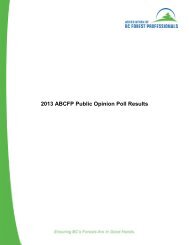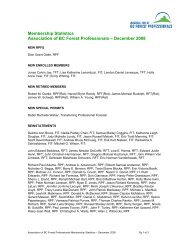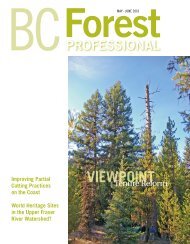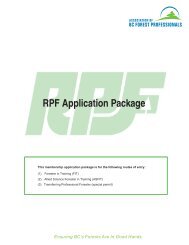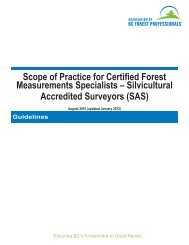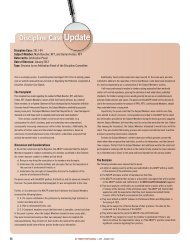VIEWPOINT - Association of BC Forest Professionals
VIEWPOINT - Association of BC Forest Professionals
VIEWPOINT - Association of BC Forest Professionals
You also want an ePaper? Increase the reach of your titles
YUMPU automatically turns print PDFs into web optimized ePapers that Google loves.
Viewpoints<br />
By Michael Feller, PhD<br />
Facing the Flames:<br />
What <strong>BC</strong> Can Learn From<br />
Australia’s Wildfires<br />
IIn February, 2009, on the most severe<br />
fire danger day in recorded history, 10<br />
major fires burned over 400,000 ha, in<br />
southeastern Australia. Several whole<br />
towns were destroyed and 173 people died.<br />
This was the third bout <strong>of</strong> severe fire in the<br />
last six years. In 2003, fires burned 1.3 million<br />
ha in the state <strong>of</strong> Victoria and in 2006<br />
again more than one million ha burned.<br />
In response, the Victorian government<br />
established a royal commission to investigate<br />
the fires. The commission’s final report is<br />
due in July 2010. However, it released an<br />
interim report in August 2009. I believe<br />
these fires and the commission proceedings<br />
have the following messages for <strong>BC</strong>:<br />
Climate Change and the Fire Regime<br />
Changing climate will alter the fire regime.<br />
Climate change models for Canada suggest<br />
increasing severity <strong>of</strong> fire weather. This is<br />
moderated in parts <strong>of</strong> <strong>BC</strong> by increasing rainfall.<br />
However, we might expect short periods<br />
<strong>of</strong> more extreme conditions followed by<br />
rainfall─perhaps similar to summer 2009. This<br />
suggests that it may not be realistic to manage<br />
for a fire regime within the known historical<br />
range <strong>of</strong> variation because that historical range<br />
occurred under different climatic conditions.<br />
Fuel Reduction and Prescribed Burning<br />
As in <strong>BC</strong>, there has been a major debate over<br />
whether the government has done enough to<br />
reduce fuels, particularly through prescribed<br />
burning. Victoria has prescribed burned over<br />
100,000 ha per year (more that 10 times greater<br />
than <strong>BC</strong>). Some people advocate burning<br />
400,000 to 500,000 ha per year. A board <strong>of</strong> inquiry,<br />
established after the 2003 fires, did not<br />
recommend an increase in burning and neither<br />
have Australia’s foremost fire ecologists.<br />
The board <strong>of</strong> inquiry recommended an<br />
increase in the effectiveness <strong>of</strong> burning<br />
for fuel reduction by targeting areas close<br />
to communities and human facilities.<br />
Prescribed burning has become a very<br />
divisive issue, as it would in <strong>BC</strong>, were <strong>BC</strong><br />
to increase the area burned to the same<br />
level as in Victoria. British Columbia<br />
should take heed from the board <strong>of</strong> inquiry<br />
and focus on, and expand, burning<br />
in critical areas, to minimize potential<br />
loss <strong>of</strong> life and property from fire.<br />
Fire Prediction Systems<br />
The Australian system used to predict fire<br />
behaviour (Fire Danger Index or FDI) has<br />
been found to be very inadequate. The failure<br />
<strong>of</strong> the FDI system to accurately predict fire<br />
16 <strong>BC</strong> FOREST PROFESSIONAL | MARCH - ApRil 2010<br />
behaviour even in the one forest fuel type for<br />
which it was developed has resulted in different<br />
systems being developed in an uncoordinated<br />
fashion for different fuel types and<br />
by different groups throughout Australia.<br />
Canada is much more fortunate in<br />
that we have unified Fire Weather Index<br />
and Fire Behaviour Prediction systems.<br />
However, these systems were generally<br />
developed for lower intensity fires, and<br />
many <strong>of</strong> <strong>BC</strong>’s fuel types are not included<br />
in the system. If we wish to avoid the<br />
piecemeal, uncoordinated approach to<br />
fire behaviour prediction that occurs in<br />
Australia, we should integrate more <strong>of</strong> <strong>BC</strong>’s<br />
fuel types into the FBP system and improve<br />
behaviour prediction, particularly <strong>of</strong> spotting<br />
potential, for higher intensity fires.



